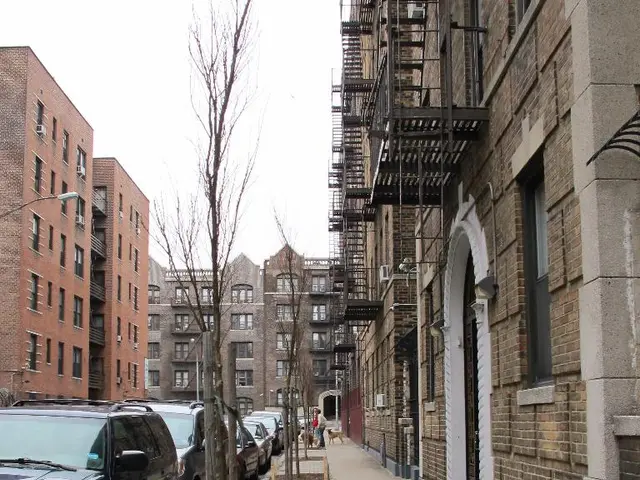Don't Get Stuck with Hefty Bills When Buying a House: Pay Attention to the Building's Age
Purchasing a Home: Take the Property's Year into Account
Bought a beautiful old Victorian house or a flat Bauhaus bungalow only to find out it needed costly renovations? Well, it's essential to consider the year of construction when hunting for a used property. This little detail often provides clues about which structural issues might crop up.
Some problems tend to arise in specific age groups of homes, leading to pricey renovation tasks. Here are the main issues you might encounter in different eras, along with some tips to help you avoid unwanted costs.
Is a house from the Gründerzeit a sound investment?
"Generally, yes," agrees specialist author Peter Burk. Pre-WW1 houses are known for their sturdy construction and enduring popularity.
However, keep in mind that during the Gründerzeit, builders mainly thought about ornamentation rather than building physics. Burk, who has penned books on property acquisition for Stiftung Warentest and Consumer Centre, warns that areas like thermal insulation, soundproofing, and cellar sealing were often overlooked back then. Furthermore, heating, plumbing, electrical installations were often underdeveloped.
But fear not! Most Gründerzeit houses are no longer in their original state. "Many owners have brought their houses up to modern standards over the years," says Corinna Kodim from Haus & Grund Deutschland. Some examples: replacement of simple windows, roof repairs, plastering walls and ceilings, and renovation of fireplaces and chimneys.
What to consider with houses built before World War II?
After the Gründerzeit, cheaper and simpler dwellings were built, following the Bauhaus philosophy – plain lines, narrow walls, single glazing. Whereas Bauhaus homes have the advantage of limited use of chemical building materials, the focus on aesthetics meant that other essentials - like insulation, soundproofing, and cellar sealing - were often inadequate, Burk states. Additionally, flat roofs, which became fashionable then, were often constructed incorrectly.
What should you be wary of when buying a house built immediately post-War?
War-built houses erected from the 1940s to the 1950s can lead to unexpected costs. This is because materials from demolished structures were frequently used, contaminated sands or fire-damaged bricks being common examples, says Klaus-Jürgen Edelhäuser from the Bayerische Ingenieurkammer-Bau. Keep in mind that the aim during this period was simply to provide people with a roof over their heads as quickly as possible.
Are houses from the 1950s to the 1970s more durable than immediate post-War constructions?
Yes, in terms of materials, but don't forget that heat and sound insulation only gained attention from the late 1970s onwards. Instead of coal, oil was increasingly used for heating. Houses from this era might need extensive renovation if they haven't already been comprehensively modernized. Moreover, flat roofs from this time might leak, while damaged pipes could've allowed water to seep into the walls over the years. Asbestos also started being used in building materials from the late 1950s and gained widespread use in the 1960s.
What are the environmental burdens in houses from the 1980s?
Even they can contain asbestos, as it was only banned in 1993. Additionally, houses from the 1980s to the 1990s often have environmental issues like mineral wool in roof insulation, formaldehyde-containing components, and harmful wood preservatives used in wooden cladding on ceilings and walls. "All of this makes them expensive to modernize and often results in damaged piping," says Burk.
These houses also tend to have high energy consumption due to insufficient attention paid to thermal insulation before the late 1970s.
Are newer houses a good deal?
Such houses are generally more energy-efficient. "Houses built after 2000 typically boast good insulation standards, efficient heating systems, smart ventilation concepts, and modern plumbing and electrical installations," says Kodim. By implementing manageable measures like eco-friendly heating, a solar power system, and better insulation, these buildings can be future-proofed.
What documents should you ask for?
"The energy certificate is crucial," advises Edelhauser. It offers information on the energy condition of the house and contains suggestions and renovation requirements. However, this certificate alone won't provide the full picture. "It's best to have access to the complete building file," recommends Kodim, which should include the building permit. If you don't have these documents, reach out to the building authority. "If there is no building permit, there's a possibility the house might need to be demolished," says Kodim, no matter its condition.
Which issues can potentially break the bank?
The energy standards of a house pose fewer problems. "It can be brought up to date with some effort," says Burk. However, if the building fabric is deteriorated or hazardous substances were used throughout, it might be better to avoid investing in such a property. "Cracks in the masonry threatening stability, dry rot, pests - they can all lead to a house's downfall," Kodim warns. Additionally, the replacement of an outdated heating system, the overhaul of sanitation and electrical installations can be costly, Edelhäuser points out.
The charm of older homes – their beautiful locations and established infrastructure – often makes them attractive choices for buyers. But their quirks can catch the unwary. Before making a purchase, it's best to consult an independent expert on the steps you should take and the financial implications of your decision.
- Community policy should address the maintenance and repair costs associated with older homes, particularly those from specific age groups, to help prevent unexpected expenses for home buyers.
- Employment policy should include provisions for home improvement and renovation work for tradespeople specializing in older buildings from the Gründerzeit, Bauhaus, and various post-war eras to cater to the demand for upgrading these properties.
- Consumer organizations like Verbraucherzentrale can provide valuable advice and tips to potential buyers on the potential weaknesses of houses built in different eras, helping them make informed decisions and avoid unwanted costs.
- When investing in a property with photovoltaic systems, it's crucial to consider the age and condition of the system and factor in the costs of maintenance or replacement to ensure long-term financial stability.
- Thorough research and consultation with experts are necessary when considering a home purchase, especially those in the lifestyle category such as home-and-garden or home-improvement projects in the housing market or real-estate realm.
- WhatsApp groups for homeowners can serve as valuable resources for discussing common issues with homes of specific age groups, sharing tips, and finding trusted professionals for repairs and renovations in various niches, such as bricklaying, plastering, or solar panel installation.








